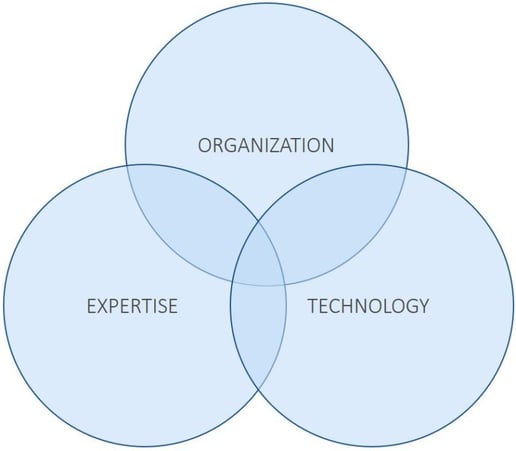This probably seems familiar. You are in charge of your company’s customer service and you would like to optimize service processes.
However, they are giving you a hard time.
-
There is your predecessor who has left stand-alone solutions for processing customer service requests. Not to mention grown and hardly standardized service processes.
-
There is your boss who is nagging you about dissatisfied customers. Processing times are far too long and failed service level agreements are causing issues.
-
In addition, there is a customer who is arguing with you about the payment of the recent fieldwork.
-
And your colleagues? They are smashing your great ideas due to a lack of resources. Besides, it would be far too time-consuming and tedious anyway.
-
Even after office hours, you will not be left alone. Your friends come for an evening at the bar with advices like “you need to get ready for the digital future”. But is it that easy? One of them is consultant and of course, he knows everything best. Telling me something about “cloud” and that it’s somehow “integrated” and “easy”. What if he was right?
Cloud – Is everything that easy?
If you believe in exaggerated promises of cloud software manufacturer, their products are mainly characterized by an easy and quick migration. Sounds good; especially if you are right now in this exact situation. Integrated processes, transparency, mobile accessibility and instant integration. Exactly what you were looking for.
However, especially on the journey to the cloud, there are three essential factors to be considered in order to guarantee project sustainability:
- Project-specific factors
- Functional factors
- Technical factors
What that means and what the result may look like in the end will be explained in the following example. The story is about an IT service provider who wants to improve on-site support for several hundred stores.

Project-specific factors
To find a suitable approach it is important that the project result is clearly defined. Depending on the objectives, different approaches are possible. Whether the traditional waterfall model, an agile approach with scrum, or a hybrid approach suits your project best, depends on diverse basic conditions.
We often recommend a mixed approach in our projects. We advise using conventional methods to define project objectives and total time frame, and recommend using scrum to process individual work packages during sprints.
The constellation of the project team is often quite challenging. At first, it is important to find the right persons with the necessary skills and convince them of the solution. Especially in the IT department, we still observe sceptics who are not enthusiastic about cloud solutions. It is about loss of control and the fear of putting sensitive data in the cloud. That is the same with our customers. Even if these apparent problems have long been solved and this group of people is getting smaller, one cannot avoid having to deal with these colleagues.
Functional factors
In addition to project-specific factors, the view from different departments decides on go or no-go of projects. But why? Different needs, perceptions and understanding of individual departments are in many cases worlds apart.
The IT service provider, who just wants to improve support, considers the sales and service department of particular importance. This illustrates how different the functional focus of the project can look like. The sales department emphasizes simple operation, reporting and opportunity management. On the other hand, the service technician sets a high value on mastering the tickets, on recording time spent and on settling accounts on-site.
Thus, requirement- and expectation management are becoming increasingly significant. In the end, it’s important for the departments to analyze their requirements critically. Are they necessary? Do they help the overall process? Which value do they generate for the customer? Is it therefore worth to deviate from the standard? Several studies show that up to 80 % of individual development is not used in day-to-day business.
Technical Factors
Obviously, technical factors also play a significant role when it comes to achieving one’s project goals. It is about questioning the current technical infrastructure critically and outlining a desired landscape.
Among other things, it is important to avoid media breaks and connect data sources properly. The new IT landscape should integrate seamlessly into existing processes and support them perfectly. Data quality measures at inbound and outbound interfaces as well as maintenance in the system itself are crucial for the sustainability of the solution. We are pointing out: Standard interfaces only run in standard mode, which means only when given context is met and dependencies, such as import sequences, are considered. They may differ if necessary, but you need to plan, design and test in advance.

How a restart becomes successful
Let’s have a look at our customer – the IT service provider. In cooperation with us, he decided to realize his requirements with the Service Cloud of SAP Hybris C4C (Cloud for Customer). In order to guarantee a successful implementation of the product, it was important to sensitize the customer for the three mentioned areas and to define framework parameters prior to the project. It was necessary to find out where (dis)satisfaction appears, both internally and with the customer, and which ideas and requirements the most important stakeholders have for a new system. Amongst other things, it became clear that due to a lack of linkage between individual areas a lot of information got lost and that the availability of current systems was limited. This led to the result that a large part of the service provided could not be settled or only be settled incompletely, which resulted in significant revenue losses. The core requirements for the project were described.
With SAP Cloud for Service into a better future
Thanks to the device-independent working, both sales and service employees can enter their information into the system on-site, even offline, saving time and avoiding errors. In addition to the fact that work becomes more efficient, the system is always up to date. Revenue fails resulting from incomplete or failed documentation could be kept to a minimum. Due to the introduction of the new software sales increased by up to 30 %. In addition, customer satisfaction has increased significantly. Due to the central customer data management, both service and sales department are always informed holistically and can act in the interests of the customer. In this particular case, SAP Hybris C4C does not only offers added value from a business perspective, but also for those employees who can do their job much better and easier.
![IBacademy_Logo_blau[496] IBacademy_Logo_blau[496]](https://www.ibsolution.com/hs-fs/hubfs/IBacademy_Logo_blau%5B496%5D.jpg?width=200&name=IBacademy_Logo_blau%5B496%5D.jpg)



